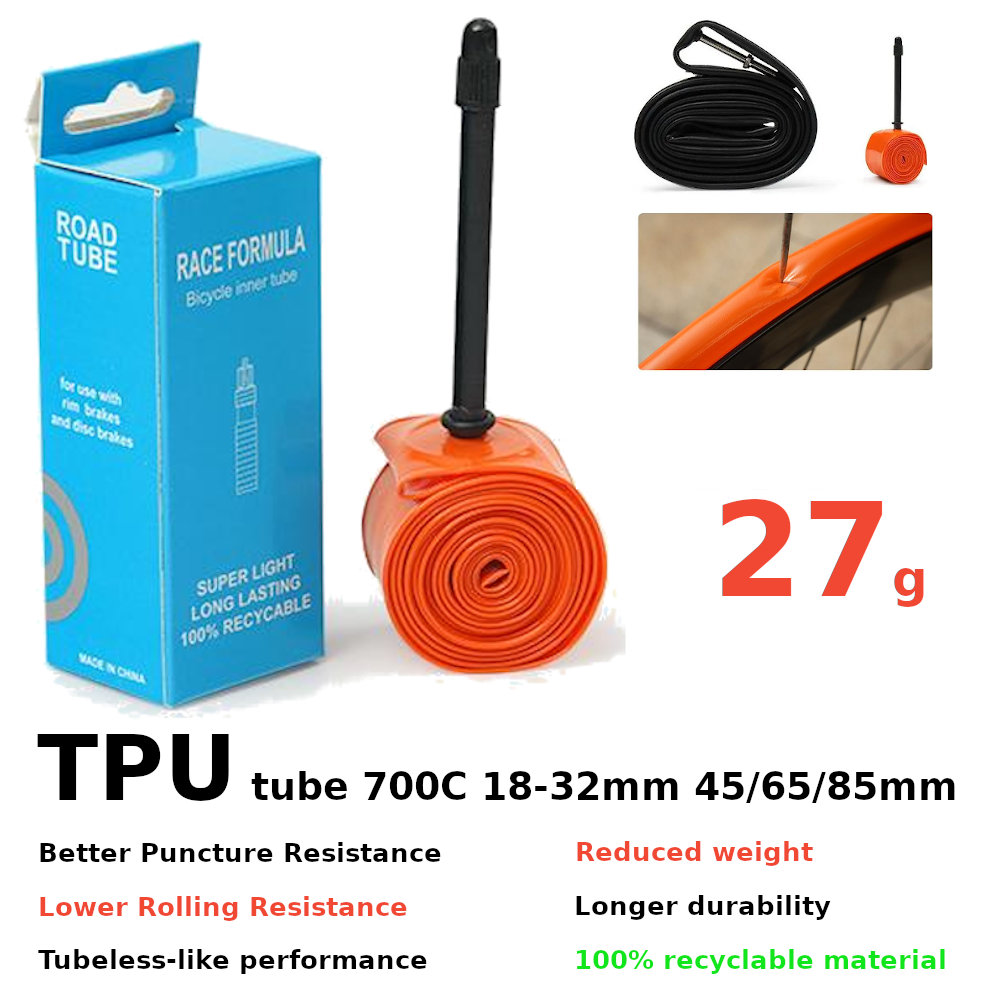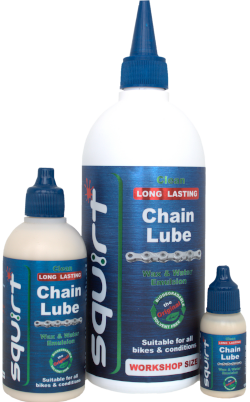
TPU tube 27g ULTRA LIGHT bicycle inner tubes
Array
14,90 лв.
Ultralight Bike Inner Tube 700C X 18-32 for Road Bicycle TPU Material Tire with Valve size: 45 / 65 / 85mm Length French Valve
1. Lightweight: TPU tubes are generally lighter in weight than traditional butyl tubes, which can help to reduce the overall weight of the bike. This can be beneficial for road bikers who are looking to increase their speed and performance.
2. Puncture Resistance: TPU tubes have a high resistance to punctures and cuts, which can reduce the likelihood of flats while riding on rough or debris-covered roads. This can help to increase the durability of the tubes and reduce the need for frequent replacements.
3. Low Rolling Resistance: TPU tubes have a lower rolling resistance than traditional butyl tubes, which means they require less effort to maintain speed and can provide a more efficient ride. This can lead to an increase in overall performance and can be especially beneficial for competitive road bikers.
4. Durability: TPU tubes are highly durable and can last longer than traditional butyl tubes. They are resistant to abrasion and are less likely to crack or puncture. This can help to increase the lifespan of the tubes and reduce the need for frequent replacements.
5. Tubeless-like Performance: TPU tubes offer some of the benefits of a tubeless system, such as lower rolling resistance, without the additional requirements of a special rim and tire setup. This can be beneficial for road bikers who want to improve their ride experience without making significant changes to their bike setup.
In summary, TPU tubes offer several advantages for road bikers, including improved performance, reduced weight, increased puncture resistance, longer durability, and tubeless-like performance. These benefits can help to provide a more efficient and enjoyable ride experience for road bikers of all skill levels.
TPU (thermoplastic polyurethane) tubes are generally considered to be reliable for a wide range of applications. TPU is a highly durable and flexible material that is resistant to abrasion, chemicals, and UV light, making it suitable for use in a variety of industries such as automotive, medical, and food processing.
The reliability of TPU tubes depends on various factors such as the quality of the material, the manufacturing process, and the application. High-quality TPU tubes that are manufactured using advanced processes are more likely to be reliable and long-lasting.
It is important to choose the right TPU tube for your specific application and to ensure that it is installed and maintained properly to ensure its reliability. Regular inspections and maintenance can help identify any issues early on and prevent failures.
Overall, TPU tubes are widely used and considered to be a reliable choice for many applications.
TPU (thermoplastic polyurethane) tubes are one of the newer types of inner tubes on the market for road bikes, and they offer some unique advantages compared to other types of tubes.
Here are some comparisons between TPU tubes and other inner tubes commonly used for road bikes:
TPU tubes vs. Butyl tubes: Butyl tubes are the most commonly used type of inner tube for road bikes, and they are known for being affordable and durable. However, TPU tubes offer several advantages over butyl tubes. TPU tubes are lighter in weight, more puncture-resistant, and have lower rolling resistance than butyl tubes, which can lead to better performance on the road.
TPU tubes vs. Latex tubes: Latex tubes are a premium option for road bike inner tubes, known for their low rolling resistance and supple ride quality. However, they are also more expensive and less durable than butyl or TPU tubes. TPU tubes offer some of the same advantages as latex tubes, such as low rolling resistance and a smooth ride, but they are more durable and puncture-resistant.
TPU tubes vs. Tubeless: Tubeless systems are becoming more popular in the road bike world, as they eliminate the need for an inner tube altogether. However, they require a special rim and tire setup and can be more difficult to install and maintain. TPU tubes offer a simpler and more affordable option for riders who want some of the advantages of a tubeless system, such as lower rolling resistance, without the additional setup requirements.
In summary, TPU tubes offer several advantages over other types of inner tubes commonly used for road bikes, including lower weight, better puncture resistance, and lower rolling resistance. However, each type of tube has its own strengths and weaknesses, and the best choice will depend on the rider's specific needs and preferences.
This inner tube cannot be inflated a lot when it is not installed in the outer tire, otherwise it will cause irreversible damage!
Please use a manual air pump instead of high-speed air filling equipment such as air compressors or pumps.
Before inflating the TPU tube, turn the valve inward (towards the center of the tire circle).
Inflate a small amount until the inner tube is round; this pressure should be less than 0.5 bar/8 PSI.
Tire inflation pressure must not exceed 5 bar/72PSI When using rims with a no-ring-lip system according to ISO/TC 31.
Every 3° (5°F) increase in temperature would increase the tire pressure by about 1%.
If you inflate the tires in a cool garage in the morning (18°C / 65°F) and ride later at higher ambient temperatures (35°C / 95°F), it may result in an increase in inner tube pressure (e.g. 0.5 bar/8 PSI).
Especially when riding on high temperature black asphalt pavement with temperature exceeding 65°C (150°F), the tire pressure may easily exceed the allowable maximum value.
In addition, too high tire pressure can cause the tire to break away from the rim during cycling, which can result in the risk of injury.
If pneumatic tires are stored at 60°C (140°F) or higher (e.g. in a car in hot weather), deflate the inner tube to 1 bar/15 PSI to avoid valve deformation.
Notification about new blog posts:
